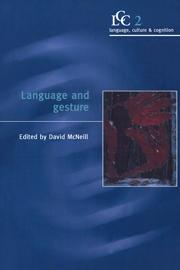Book contents
- Frontmatter
- Contents
- Acknowledgments
- Introduction
- Part 1 Gesture in action
- Part 2 Gesture in thought
- 7 Growth points in thinking-for-speaking
- 8 How representational gestures help speaking
- 9 Where do most spontaneous representational gestures actually occur with respect to speech?
- 10 Gesture production during stuttered speech: insights into the nature of gesture–speech integration
- 11 The role of gestures and other graded language forms in the grounding of reference in perception
- 12 Gesture and the transition from one- to two-word speech: when hand and mouth come together
- Part 3 Modeling gesture performance
- Part 4 From gesture to sign
- Index
11 - The role of gestures and other graded language forms in the grounding of reference in perception
Published online by Cambridge University Press: 07 January 2010
- Frontmatter
- Contents
- Acknowledgments
- Introduction
- Part 1 Gesture in action
- Part 2 Gesture in thought
- 7 Growth points in thinking-for-speaking
- 8 How representational gestures help speaking
- 9 Where do most spontaneous representational gestures actually occur with respect to speech?
- 10 Gesture production during stuttered speech: insights into the nature of gesture–speech integration
- 11 The role of gestures and other graded language forms in the grounding of reference in perception
- 12 Gesture and the transition from one- to two-word speech: when hand and mouth come together
- Part 3 Modeling gesture performance
- Part 4 From gesture to sign
- Index
Summary
Introduction
Humans acquire knowledge in two major ways – by perceiving their environment and by perceiving and comprehending communications involving language. In principle, some knowledge acquired by perceiving the environment can be certain knowledge, because perception of the environment can be ‘direct’ (e.g., Gibson 1979). Knowledge acquired by language is likely to be less certain, because it cannot convincingly pass the tests for directness of perception.
We will suggest, however, that speakers do provide some directly perceivable information to listeners. The information takes the form of increases and decreases in what we will call the energy expended to communicate. This is manifested as the occurrences of longer or shorter, more carefully or more casually articulated lexical expressions accompanied or not by manual gestures. Energy peaks (long carefully articulated expressions accompanied by a gesture) mark topic shifts. Peaks and troughs can help to specify reference.
Before presenting the data, we clarify our distinction between direct perception and less reliable means of acquiring knowledge. Next we discuss sources of information about reference and topic shifts.
Direct perception and less reliable ways of acquiring knowledge
Perception of the environment is direct if it is unmediated by construction of covert representations of the environment being perceived and if it is unmediated by guessing that is required when stimulus information is insufficient to specify its source. Here is how perception of the environment can be direct.
Components of the environment lawfully structure media such as light and air; the light and air in turn impart their structure to the perceptual systems of perceiver/actors.
Information
- Type
- Chapter
- Information
- Language and Gesture , pp. 215 - 234Publisher: Cambridge University PressPrint publication year: 2000
Accessibility standard: Unknown
Why this information is here
This section outlines the accessibility features of this content - including support for screen readers, full keyboard navigation and high-contrast display options. This may not be relevant for you.Accessibility Information
- 17
- Cited by
